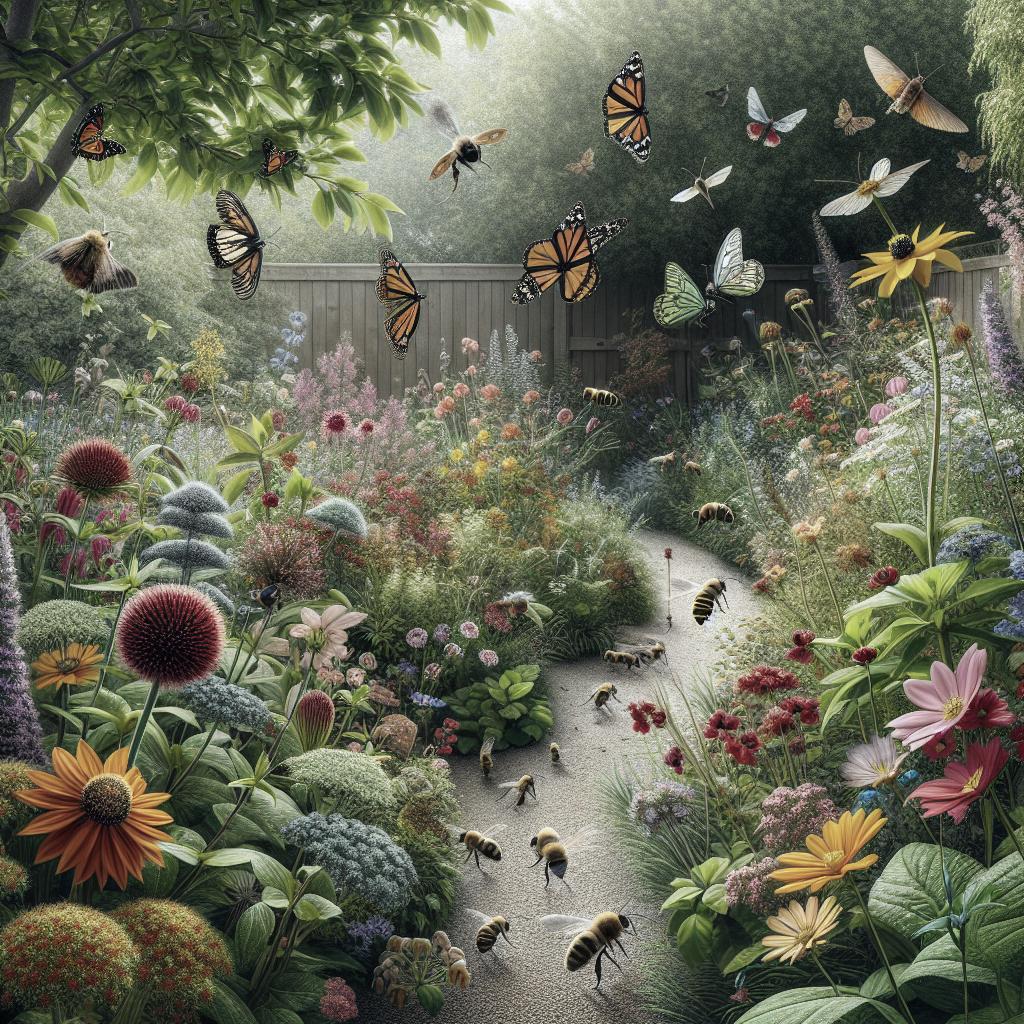“`html
How to Create a Pollinator-Friendly Garden
Creating a pollinator-friendly garden is a rewarding endeavor that not only beautifies your outdoor space but also aids in the survival of crucial species such as bees, butterflies, and other pollinators. This post will guide you through the process of planning and planting a thriving oasis to attract and sustain pollinators. We will discuss how to carefully select a location for your garden, identify your soil type, and pick the right plants. Additionally, you’ll discover how to effectively plant and maintain your garden, ensuring it becomes a safe haven for your pollinating visitors. Embark on this exciting journey to contribute positively to the environment while enjoying the splendor of nature.
Planning your garden
Choosing your location
When planning a pollinator-friendly garden, the first step is selecting the right location. Ideally, your garden should be placed in an area that receives ample sunlight, as many pollinators, like bees and butterflies, are drawn to warm, sunlit spaces. Consider areas that are sheltered from high winds, which can be detrimental to both plants and pollinators. A balance of sunlight and protection will create an inviting environment.
Moreover, accessibility is key. Having your garden close to a water source will ensure that regular watering is manageable and convenient. Access to a nearby water source can provide additional benefits, such as periodically spraying to mimic gentle rain, which can further appeal to pollinating species.
Identifying soil type and sunlight
Understanding your soil type is crucial in cultivating a garden that thrives. Test your soil to determine its pH and nutrient levels; you can purchase a simple soil test kit from a garden center. With these results, you can amend the soil as needed to create the ideal conditions for plant growth.
Alongside soil, consider the lighting of your chosen location. Most pollinating plants prefer full sun, though some can tolerate partial shade. Observe how the sunlight moves through your garden throughout the day to refine your planting strategy.
Choosing your plants
In a pollinator-friendly garden, diversity is essential. Choose a wide range of plants that bloom at different times of the year. This ensures that pollinators have a continuous food supply. Native plants are particularly effective, as pollinators are naturally adapted to them, requiring less maintenance and thriving local fauna.
To maximize attractiveness, incorporate a variety of flower shapes and colors. Pollinators are drawn to vibrant hues and distinct flower forms, making your garden visually appealing and ecologically valuable.
Seeds vs. plants
Deciding between seeds and pre-grown plants depends on your preferences and resources. Starting from seeds invites a deeper understanding of your plants, albeit with a longer growth period. It’s a cost-effective option that can be immensely rewarding with the right care and patience.
Alternatively, selecting mature plants offers an immediate aesthetic appeal and serves the needs of pollinators sooner. This option is ideal if you’re seeking quick results or have less time for garden establishment.
Planting your garden
Prepping your garden
Proper preparation of your garden bed ensures successful planting. Begin by clearing the area of debris, weeds, and any competing vegetation. Loosen the soil to a suitable depth, incorporating organic matter like compost to enhance fertility and drainage.
Design your layout by grouping plants with similar sunlight and water needs. Keep in mind the eventual growth size of plants to prevent overcrowding, which can hinder access for pollinators.
Planting your seeds or flowers
Planting should occur during a season that aligns with the growing needs of your plants. Generally, spring is ideal for most species, offering optimal conditions for root establishment and growth. Ensure that you follow the spacing and depth guidelines provided for each species to maximize your chances of success.
When sowing seeds, lightly cover them with soil and gently pat down to ensure contact. If planting potted flowers, dig a hole slightly larger than the root ball, then backfill with soil and water generously to settle them into their new home.
Wait, watch, water, and weed
Gardening requires patience and continuous care. Regularly check your garden, ensuring it remains free from weeds and pests that could hinder growth. Weeds compete for resources, so keep them in check with mulching or manual removal.
Consistent watering is vital. Different plants have varied water needs; understanding this can prevent over or underwatering. Observe changes in your plants and the visitation patterns of pollinators. Such observations can guide improvements and inspire further adjustments to your gardening practices.
Written By
Sarah Lambert is an experienced copywriter with a passion for combining the wonders of nature with the nuances of human interaction. Leveraging her background in journalism and her interest in psychology, Sarah creates content that informs and resonates with her audience.
Story Tags
gardening, pollinators, environment, flowers, sustainability, landscaping, biodiversity
Facilities
Our garden planning toolkit offers tools and resources to enrich your gardening experience, from soil tests to plant guides, ensuring your pollinator haven thrives.
Related Stories
- The Benefits of Native Plants in Your Garden
- Top 10 Flowers to Attract Bees
- DIY Garden Projects for Beginners
Latest Stories
- Exploring the World of Urban Gardening
- Sustainable Landscaping: A Holistic Approach
- Garden Trends 2024: What’s New?
Final Thoughts
| Aspect | Details |
|---|---|
| Planning | Choose a sunny, sheltered location; assess soil and light; select a variety of native plants; consider seeds or mature plants. |
| Planting | Prepare the garden bed; plant in groups depending on their needs; water and weed regularly; observe plant and pollinator interaction. |
| Maintenance | Regularly monitor for pests and weeds; ensure adequate watering; adapt based on plant and visitor behavior. |
“`

